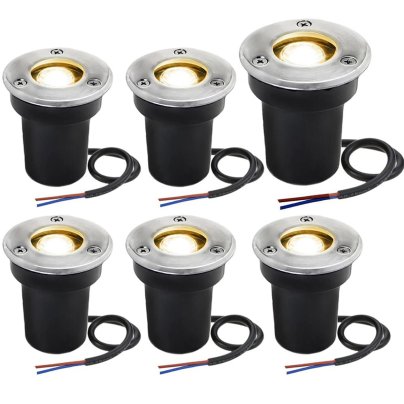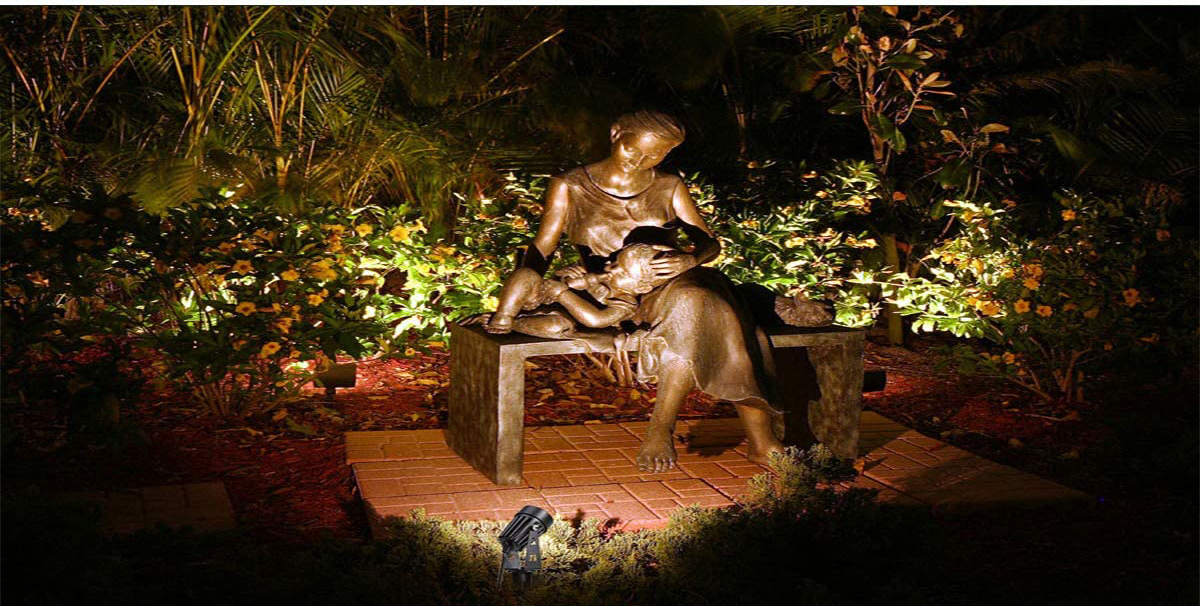
We may earn revenue from the products available on this page and participate in affiliate programs. Learn More ›
Low-voltage landscape lighting can add drama and interest to a home’s features while providing visibility for outdoor living spaces, such as backyard decks and patios. And given all the time and money homeowners invest in improving a home’s curb appeal with architectural upgrades and landscaping, why should a home only be visible during the daytime?
Low-voltage landscaping lights come in a wide variety, ranging from bullet lights for spotlighting statues and water features to floodlights for highlighting a home’s facade to well lights for illuminating mature trees. This guide covers the main features to consider while shopping and reviews some of the best low-voltage landscape lighting on the market.
- BEST OVERALL: Greenclick Landscape Lighting Extendable LED Lights
- BEST BUDGET: sunpo Solar Lights Pathway Landscape Lights
- BEST WELL: SUNRIVER Low Voltage Landscape Lights LED Well Lights
- BEST FLOOD LIGHTS: Newhouse Lighting Aluminum LED Wall Wash Flood
- BEST SPOTLIGHTS: Lumina 4W LED Landscape Lights
- BEST GARDEN LIGHTS: hykolity 6 Pack Low Voltage LED Landscape Pathway
- BEST BULLET LIGHTS: Newhouse Lighting Spotlight

What to Consider When Choosing the Best Low-Voltage Landscape Lighting
There are numerous factors to consider when selecting the right lighting for residential property, including the type of lights, power source, location, and weather resistance. Read on to learn more about the important attributes of landscape lighting.
Bulb Type
Bulb type makes a difference, especially when it comes to brightness and energy efficiency. For low-voltage landscape lighting, LED bulbs are the preferred way to go. They’re brighter than incandescent bulbs and use about 80 percent less electricity. The bulbs also last much longer than incandescent bulbs and burn much cooler.
LED bulbs are a much bigger investment upfront, costing around three or four times that of an incandescent bulb. However, due to their longevity and energy savings, these bulbs eventually pay for themselves and beat out incandescent bulbs in total cost.
Another option is solar lighting. Solar landscape lighting uses a small solar cell to charge a battery that provides power for the lights when the sun goes down. Although solar lights do not require electricity or wiring, they’re usually not as bright as low-voltage lighting.
Power Source
Low-voltage landscape lighting gets its name from its use of 12-volt energy. It requires a transformer that converts standard 120-volt electricity in the home to 12-volt electricity. Outdoor light fixtures compatible with 12-volt systems are daisy-chained together to the transformer.
Since 12-volt electricity does not present the risk of electric shock, low-voltage landscape lighting systems are safe for homeowners to install on their own. The user also does not have to bury the wires in the ground and can instead run them across the top of the ground under a thin layer of dirt or mulch.
Some landscape lighting uses solar power instead of low-voltage electricity. Solar power landscape lighting is easier to install because it doesn’t require wiring, instead relying on a battery that charges throughout the day using a solar cell. A fully charged battery can provide nighttime lighting for 8 to 12 hours. Remember that solar-powered landscape lighting must have at least 6 hours of direct sunlight each day to recharge fully.
Brightness and Color Temperature
The brightness of a landscaping light depends on the type of light as well as its power source. A bullet light, which functions like a spotlight powered by a 12-volt transformer, will produce around 1,500 lumens, enough to light up the facade of a house. Well lights, which are ideal for uplighting a tree or wall, produce around 100 lumens, while low-voltage garden lights that illuminate flower beds or pathways might produce between 200 to 300 lumens.
A landscaping light fixture powered by a 12-volt transformer creates significantly more lumens than a solar-powered light. A pathway light powered by 12-volt electricity may generate 150 lumens, a solar-powered pathway light may only produce 7 lumens.
In addition to brightness, landscape lights also have different color temperatures. Color temperature creates the look and feel of lighting and ranges from warm white to daylight. The Kelvin (K) scale measures color temperature. Home lighting typically ranges between 2,000K and 6,500K, with the lower number being warmer and the higher number being cooler. A light that rates 2,500K is warm and white with a cozy feel, while a 5,000K light is similar to daylight, creating a crisp feel for working.
While nighttime landscape lighting should provide some visibility, it should not have the same effect as the lighting in a football stadium. Landscape lighting should create a more nuanced feel with a color temperature between 2,000K and 3,000K.
Weather Resistance
Since landscape lighting operates outdoors, it must be able to endure the elements. Most landscape lighting consists of aluminum because it’s naturally resistant to rust and corrosion. It’s also tough enough to survive occasional impacts from feet, trimmer lines, or lawn mowers. Some landscape lighting, such as well lights, feature shock-resistant tempered glass.
Low-voltage landscaping uses electrical wiring. This means it must be able to resist water and impact. Consumer outdoor electrical devices have an International Protection Code (IP code), that rates how well the device protects the electrical component from dust and water. All types of low-voltage or solar landscape lighting should have an IP 65 rating or higher, which means the light resists dust particles and jetting water, such as from a sprinkler or hard rain.
Some types of landscape lighting, such as well lights that are buried in the ground, have a higher IP 67 rating, which indicates the light can endure temporary submersion underwater.
Size and Style
- Garden: Garden-style landscape lighting sits on a post between 18 and 24 inches high with a canopy shade that reflects the light from the bulb downward, creating a pool of light just beneath it. Garden lights are ideal for marking pathways or for use as flower bed lights.
- Wash: A wash light brightens a broad space such as the side of a home, wall, or fence. Wash lighting fixtures are mounted near the base of the structure and shine upward.
- Bullet: Bullet lights function as a spotlight, directing a narrow beam for lighting specific features, such as the trunk of a tree or an aesthetic detail on a home. A bullet light’s beam width is measured in degrees. The lower the degrees, the narrower (and brighter) the beam of light.
- Well: Well lights sit in the ground at the base of a tree and shine upward, illuminating the branches. One can also install them near the foundation of the home to illuminate the facade.
- Downlight: Downlights mount in a tree or on the side of the home and shine down through the branches, creating shadows on the lawn, patio, or pathway below that mimics moonlight. These fixtures typically have a cylindrical shade that surrounds the bulb to prevent side glare.
- Floodlight: This type of light is similar to the floodlights used for security and visibility commonly mounted to a home’s eave. Floodlights project a wide beam that creates a broad wash of light. They’re ideal for illuminating a house’s facade, wall, or fence. They create an effect similar to a wash, only brighter.
Location
- Facade: There’s no reason a home’s curb appeal can’t be visible when the sun goes down. Washes and floodlights that illuminate a home’s facade can add drama and sophistication to a property.
- Trees: Trees can benefit from downlighting or uplighting. Downlighting creates the effect of moonlight shining down through the branches. This type of lighting is especially effective for creating interesting shadows on walks, driveways, and paths beneath the tree branches. Uplighting is effective for highlighting the textures and foliage of a large tree while adding a dramatic feel.
- Gardens and beds: For garden beds with low flowers and plantings, garden lights are an effective way of showcasing them during the nighttime hours. Choose garden lights that are taller than the plants, so they cast light down on the foliage below.
- Backyard patios: For backyard patios surrounded by trees, use tree-mounted lights that shine downward. The light’s position in the trees will create more nuanced lighting that allows for needed visibility for nighttime entertaining while also casting interesting shadows and textures from the foliage of the trees onto the patio or deck.
- Lawn ornaments: Use a bullet light to spotlight specific objects, such as a statue, water fountain, or other architectural feature on a home.
Installation
An electrician is required when installing a transformer for a low-voltage lighting system. Once that’s in place, however, adding and installing the lights is something most DIYers can accomplish without any special skills or tools. Installation involves installing the light fixtures by staking them in the ground or attaching them to trees, then running the wires from light to light and then to the transformer. Low-voltage systems have little risk of electric shock; this makes the installation process a doable job for most DIYers.
Solar systems are even easier to install. They require no transformer or electrical wiring thanks to individual solar cells and batteries. Installing these lights involves staking them into the ground in an area that gets at least 6 hours of direct sunlight each day.
Our Top Picks
The list below includes some of the best low-voltage landscaping lights on the market. Each product is ranked by type, power source, and budget. Any one of these products will help illuminate a home’s architectural and landscaping features at night.
Best Overall
Greenclick Landscape Lighting, Extendable LED Lights
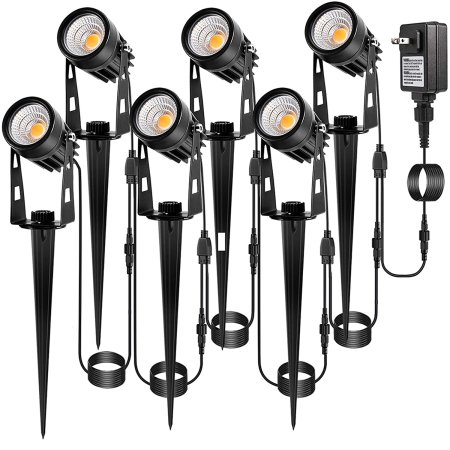
Pros
Cons
Product Specs
- Power Source: Plug-in/transformer
- Brightness: 300 lumens (per light)
- Recommended Location(s): Walls, trees, flags, and pathways
Tremendous light output coupled with efficient energy use and solid construction makes this set of LED landscaping lights a top pick for highlighting a home’s natural and architectural features. This six-pack set of lights uses 3 watts each, producing 300 lumens.
Greenclick’s LED Garden Lights are ideal for illuminating the facade of a home or larger trees without lighting up the electric bill. For larger homes that require more lights, this set is extendable to include an additional two lights or even more with the purchase of an extension cable.
A 54-degree beam angle and head that adjusts 270 degrees make them easy to aim for lighting a home’s facade, a statue, or medium- to large-size trees. Each light produces a warm color that measures 2,700 on the Kelvin scale. With their aluminum construction, these water-resistant lights, which won’t crack or rust, are compatible with 12-volt systems.
Best Budget
sunpo Solar Lights Pathway Landscape Lights
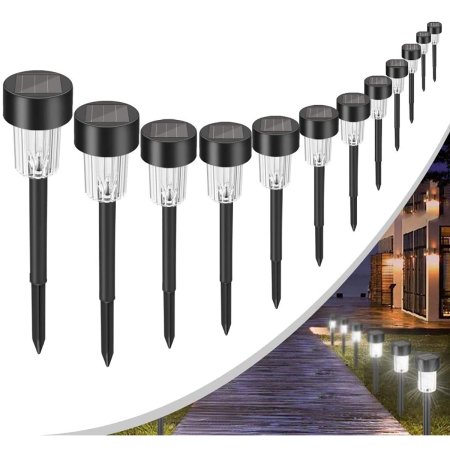
Pros
Cons
Product Specs
- Power Source: Solar
- Brightness: 1.5 lumens (per light)
- Recommended Location(s): Yards, patios, walkways, driveways, and flowerbeds
Adding lighting to the exterior of a home doesn’t have to be a significant investment. Low-voltage landscape lighting kits, like this 4-pack of lights, offer an inexpensive way to light a walkway or flower bed at a fraction of the cost of other landscape lighting.
The housing on these lights consists of weather-resistant plastic. They produce only 1.5 lumens but create a brighter and whiter color than most other low-voltage LED pathway lights at 5,000K. A solar cell means they’ll add no cost to the monthly electric bill.
They charge to full power with 6 hours of sunlight and can run for up to 8 hours at night. A convenient sensor automatically turns the lights on at dusk and off at dawn. Installation is easy with no wiring required and a large ground stake that holds each light firmly upright.
Best Well
SUNRIVER Low Voltage Landscape Lights LED Well Lights

Pros
Cons
Product Specs
- Power Source: Transformer
- Brightness: 100 lumens (per light)
- Recommended Location(s): Pathways, flower beds, tress, pool areas, and decks
Well lights are buried in the ground, so they need to be more durable than other types of landscape lighting. The rugged construction of this six-pack of fixtures from Sunriver enables them to withstand the rigors a well light must endure. The lamp has a tempered soda-lime glass lens, which can absorb high impacts from yard maintenance equipment and feet without cracking.
Pressure rubber gaskets create a watertight seal (it has an IP67 rating) preventing rainwater from infiltrating the light fixture, even if water pools above it. Each light puts out a powerful 100 lumens at a broad 90-degree beam angle, making it ideal for illuminating the facade of a house or a large tree. This light’s wiring makes it compatible with 12-volt landscape lighting transformers and higher output 24-volt systems.
Best Flood Lights
Newhouse Lighting Aluminum LED Wall Wash Flood
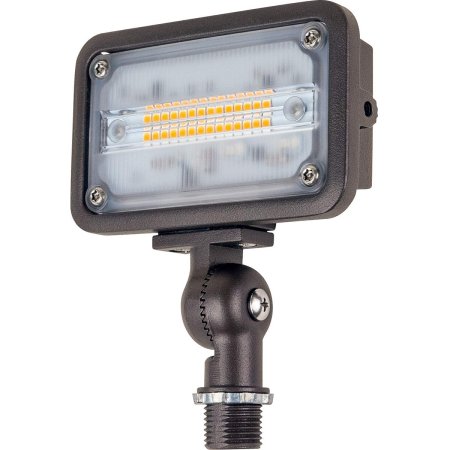
Pros
Cons
Product Specs
- Power Source: Transformer
- Brightness: 1,500 lumens
- Recommended Location(s): Signage, walls, yards, gardens, and driveways
This light’s brightness, energy efficiency, and quality construction make it an excellent floodlight option for landscape lighting. It features a powerful 1,500-lumen LED bulb that’s bright enough to create a wash over a broad surface to a height up to 100 feet, such as a garden wall or home facade. With its 3,000K bulb, it creates a soft white glow.
The housing is rust-resistant aluminum with an attractive bronze finish and frosted lens. With an LED bulb that consumes just 16 watts and lasts 20 times longer than standard halogen flood light bulbs, this fixture is also energy efficient. A stout stake that mounts into the ground and an adjustable knuckle make it easy to install and aim this fixture to light a house facade, fence, or wall.
Best Spotlights
Lumina 4W LED Landscape Lights

Pros
Cons
Product Specs
- Power Source: Transformer
- Brightness: 400 lumens (per light)
- Recommended Location(s): Walls, fences, walkways, gardens, and patios
Durability, an attractive look, and energy efficiency are excellent characteristics of a landscape light, and these bullet-style lights have all three. This light eschews cheaper plastic to go with a cast-aluminum housing in a handsome bronze or black finish. The head adjusts 160 degrees, enabling the user to find just the right angle for highlighting walls, facades, fences, and other features.
Each 3,000K bulb produces a warm white light with 400 lumens. The lights are more expensive than other models but include LED bulbs, which are more energy efficient than incandescent options. These bullet lights come in pairs, mount into the ground with a stake, and are compatible with most low-volt systems.
Best Garden Lights
hykolity 6 Pack Low Voltage LED Landscape Pathway
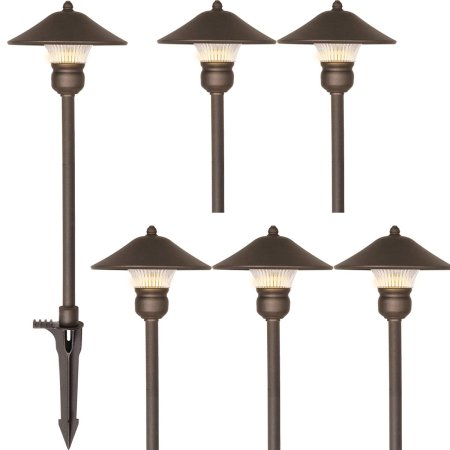
Pros
Cons
Product Specs
- Power Source: Transformer
- Brightness: 150 lumens (per light)
- Recommended Location(s): Walkways, driveways, patios, pool areas, and gardens
Garden lights need to be attractive and functional. This set of low-voltage path lights from Hykolity is both, thanks to durable construction and a simple yet elegant look. These lights consist of cast aluminum capable of withstanding the elements with a sturdy stake that ensures they’ll stay upright.
The cone-shaped hood creates a streamlined look that makes the fixture suitable for various home styles while casting a wide 139-degree beam angle with 3,000K soft white light. Each LED light uses just 3 watts but provides ample brightness with 150 lumens.
With six fixtures, this set includes enough lights for lighting a path or illuminating several large flower beds. Its 15-inch cables with quick-connect wire connectors make installing the lights to a low-voltage transformer a relatively easy job for a DIYer.
Best Bullet Lights
Newhouse Lighting Spotlight
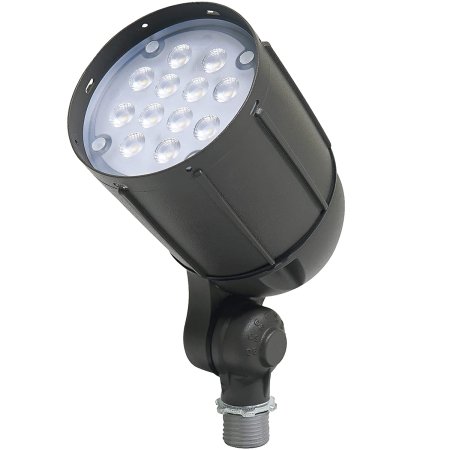
Pros
Cons
Product Specs
- Power Source: Transformer
- Brightness: 1,400 lumens
- Recommended Location(s): Signs, walls, flags, patios, pool spaces, and gardens
This LED bullet light’s powerful 1,400-lumen brightness makes it equivalent to about a 75-watt spotlight while being more energy efficient—it uses just 12 watts of power. A 40-degree beam angle that creates a medium-size spotlight and a bracket that allows for a wide range of adjustment makes this fixture versatile enough to illuminate the front of a home, a tall wall or fence, or a mature tree.
Its 3,000 rating on the Kelvin scale gives it a soft white color temperature. A durable aluminum housing with a bronze patina adds durability and style, while a large stake firmly anchors this light into the ground.
Our Verdict
It can be hard to select the perfect low-voltage landscape lighting when there are so many options available. One of the best transformer-powered options overall is the Greenclick landscape lights with over 300 lumen brightness in each of 6 lights, their adjustable 54-degree beam angle, and 2,700K color.
Alternatively, the sunpo landscape lights are solar powered and come with a much smaller price tag. With 1.5 lumens offered per light, each unit stays on for 6 hours after an 8-hour charge and emits a bright, 5,000K light color.
How We Chose the Best Low-Voltage Landscape Lighting
We researched the most sought-after low-voltage landscape lighting options in their respective categories and discovered that the best models are easy to install, emit ample amounts of light, and are sturdy enough to withstand the elements.
After researching the best low-voltage landscape lighting, most prefer transformer-powered models for their reliability and ample brightness. However, the above solar-powered options are a suitable choice for those that prefer outdoor lights that require little maintenance and no tricky installations. For your yard, driveway, walkway, pool space, trees, or patio, the above picks range from 100 to 1,500 lumens based on your personal preference.
As for light color, our selection ranges from 2,700 to 5,000K color temperatures for warm or cool lighting. Waterproofing and weather resistance was also a factor considered when choosing our top picks, as most models listed are made to be durable with aluminum, cast aluminum, and plastic constructions.
FAQs
If you’re wondering how bright your landscape lighting needs to be or how to use your low-wattage landscape lighting safely, then read on for answers to commonly asked questions about this type of outdoor lighting.
Q: Is low voltage lighting safe?
Low voltage lighting refers to the process of using a step-down transformer to reduce the home’s 120V electrical supply to 12V. This change makes low voltage lighting safer to install and maintain because the maximum electrical charge is reduced by 90 percent.
Q: Does low voltage mean low hazard?
While low voltage lighting is less dangerous than standard lighting, this doesn’t mean that it’s low hazard. Always wear appropriate safety equipment when working with electrical systems to help avoid accidental injuries.
Q: How many lumens do I need for landscape lighting?
The brightness of the landscaping light depends on the type and application. While a pathway light may require as few as 2 or 3 lumens, a floodlight illuminating the entire facade of a house may need as much as 1,400 lumens, depending on the size of the home.
Q: How far can you run low-voltage landscape lighting?
The distance you can run low-voltage landscape lighting depends on the gauge of the wiring and the wattage of the lights. Most low-voltage landscape lighting uses 12-gauge wire, which can run for up to 100 feet with a total load of 100 watts or less without any drops in voltage.
Q: Does low-voltage wiring need to be in a conduit?
No. Low-voltage wiring does not need to be in a conduit. Since it is low voltage, it does not present the risk of electric shock of standard 120-volt home wiring.
Q: Can you get electrocuted from low-voltage lighting?
No. Since low-voltage wiring carries a maximum of 12 volts, it’s safe to handle, even when there is electricity flowing through the wires. This also means pets and children playing around low- voltage lighting and wiring are safe from electric shock.
Q: How deep do you bury low-voltage wire?
When low-voltage wiring crosses a lawn or other traffic areas, it’s best to bury it about 6 inches deep. While this wiring does not present the risk of electric shock, foot traffic and lawnmower blades can damage it.
Q: How much does it cost to install low voltage landscape lighting?
Low voltage landscape lighting costs can range from $250 to over $1,000 depending on the size of the system, the quality of the lights, and the electrical infrastructure, like wiring and the transformer.
Q: How do you hook up low voltage landscape lights?
Connect low voltage landscape lights by mounting the transformer close to an outdoor GFCI outlet. Strip the tips of the wires on the two conductors that will feed landscape lights, then attach each conductor to the terminals on the transformer according to the manufacturer’s directions.
Plan and measure the layout of the low voltage lights before driving them into the ground. Run the cable from the transformer along the path of lights and use the quick-connect system to open the housing on each light and slip the electrical cable inside. Secure the connector with electrical tape, then repeat the process for each light fixture.
Plug in the transformer and turn the system on. If everything is working correctly then you can dig a narrow trench and bury the cable along the path of the lights.
Q: Do low voltage wires need to be capped?
It’s always a good idea to cap your wires, even if they are low voltage because an exposed wire can lead to shorts in the system. Additionally, if the exposed wire comes in contact with a higher voltage system, the increased voltage will damage any lights attached to the low voltage system.
Q: How many lights can you put on a low voltage transformer?
The number of lights that you can put on a low voltage transformer depends on the specific lights, as well as the specific transformer. First, determine how many watts the transformer can hold, then determine the amount of watts each fixture consumes.
Add the watts consumed by each fixture to find the total watts consumed by the low voltage system. If the total watts consumed is less than the total number of watts the transformer can hold then all of the lights fit on one transformer. However, if the total watts consumed exceeds the total number of watts the transformer can hold, then you will need a second transformer.


